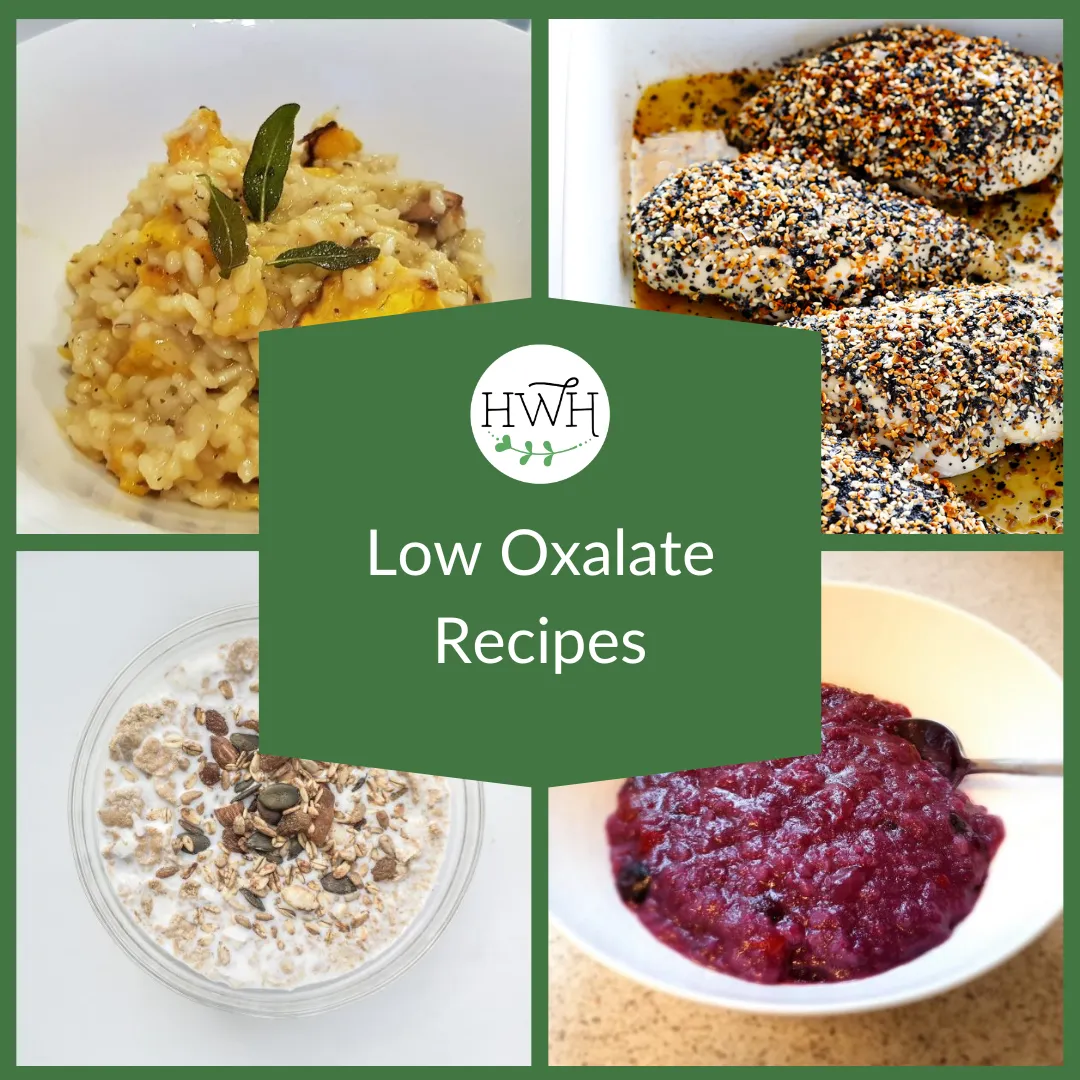Oxalates and histamine intolerance are two separate, yet sometimes overlapping issues that can significantly impact those sensitive to them. It’s essential to understand how these compounds function, where they are found in foods, and how they can overlap, especially for individuals with histamine intolerance.
In this month’s blog, I discuss what oxalates are, why they can be an issue and what signs to watch for.
What Are Oxalates?
Oxalates are naturally occurring compounds found in a variety of plant foods, and they serve as part of a plant’s defence mechanism. Once consumed, oxalates can bind to minerals like calcium and iron, forming crystals that are difficult for the body to excrete. High levels of oxalates in the body may contribute to the formation of kidney stones and exacerbate inflammatory conditions. Oxalates and the plants themselves are not dangerous if you have a good range of gut bacteria, some of which consume oxalate.
Oxalates are commonly found in foods like spinach, kale, beets, rhubarb, almonds, and certain teas. Individuals with a history of kidney stones or oxalate sensitivity may need to manage their oxalate intake through dietary modifications to reduce the risk of stone formation or other health issues.
For people with histamine intolerance, oxalates may worsen symptoms by adding another layer of stress on the body’s detoxification systems. Those who have issues like leaky gut, poor liver function, or reduced kidney function may have a harder time processing oxalates, leading to a buildup that can trigger or worsen inflammation, joint pain, and digestive disturbances.
What is Histamine Intolerance?
A brief overview of histamine intolerance: It happens when the body is unable to effectively break down histamine. Normally, the body can break down histamine through the enzyme diamine oxidase (DAO). However, some people have reduced levels of this enzyme or impaired gut health, making it difficult to break down excess histamine from food, leading to symptoms such as headaches, skin rashes, digestive issues, and asthma-like symptoms. Read more about Histamine Intolerance here.
The Overlap Between Oxalates and Histamine Intolerance
While oxalates and histamine intolerance are different concerns, they often overlap in practice, particularly when it comes to gut health. Both conditions can be exacerbated by impaired digestion, and many people with one condition might unknowingly have issues with the other.
For instance, gut dysbiosis (an imbalance of gut bacteria) can impair the body’s ability to break down both histamines and oxalates. One gut bacteria called Oxalobacter formigenes produce an enzyme called oxalyl-CoA decarboxylase, which helps break down oxalates, while other strains metabolize oxaltes and histamine. When the gut is out of balance, it can lead to an inability to properly metabolize either compound, thus worsening symptoms for those with histamine intolerance and those sensitive to oxalates.
Plus, the Oxalobacter formigenes bacteria are vulnerable to antibiotic use. Frequent use of antibiotics often eliminates this bacteria responsible for breaking down oxalates. Decades ago, before antibiotics were so commonly used, oxalate overload wasn’t as widespread.
Additionally, chronic inflammation caused by high histamine levels can impair kidney function over time, making it harder to excrete oxalates. This further highlights the importance of addressing both histamine intolerance and oxalate sensitivity in people with overlapping symptoms. You can try a low histamine and Low oxalate diet with this recipe book.
Key Symptoms of Oxalate Sensitivity
- Joint pain or arthritis-like symptoms
- Recurrent kidney stones
- Skin irritation or rashes
- Fatigue or brain fog
- Vulvodynia
- Digestive issues such as bloating, constipation, or diarrhea
Key Symptoms of Histamine Intolerance
- Migraines or headaches
- Skin reactions, such as hives or rashes
- Respiratory issues, such as sinus congestion or asthma-like symptoms
- Digestive discomfort, including nausea,constipation, diarrhea, bloating, and heartburn
- Flushing or skin redness
As you can see, there is often an overlap in symptoms, therefore making it hard to distinguish what is going on.
What is Oxalate Dumping?
Have you ever heard of the term, Oxalate dumping? This term is used to describe the process in which the body begins to release and excrete stored oxalates after a reduction in dietary oxalate intake.
When a person cuts down on dietary oxalates, the body can start releasing these stored oxalates in an effort to restore balance. However, this sudden release of oxalates can overwhelm the body’s natural detoxification pathways (like the kidneys and liver), leading to a variety of symptoms. This can feel overwhelming, making people feel worse before they feel better.
Symptoms of Oxalate Dumping
When the body begins to excrete oxalates, the process can manifest with various symptoms, often mimicking or exacerbating existing health issues. Common symptoms include:
- Joint or muscle pain: Due to oxalate crystals being released from tissues, some people experience an increase in inflammation and pain, particularly in areas prone to oxalate buildup like the knees or elbows.
- Fatigue or brain fog: The stress of detoxifying oxalates can lead to increased tiredness and cognitive issues, as the body expends more energy to eliminate them.
- Digestive disturbances: As oxalates exit the body through the gut, symptoms like bloating, cramping, diarrhea, or constipation may occur.
- Urinary symptoms: Since oxalates are often eliminated through urine, some may experience burning, increased urgency, or discomfort while urinating.
- Skin reactions: Skin can sometimes act as a secondary elimination pathway, leading to rashes, itching, or irritation as oxalates are excreted through sweat.
- Kidney stones: If a person is prone to kidney stones, oxalate dumping can temporarily increase the risk of stone formation as the body excretes oxalates through the kidneys.
What Triggers Oxalate Dumping?
Oxalate dumping is usually triggered when a person who has been consuming high-oxalate foods suddenly reduces or eliminates those foods from their diet. This change signals the body that it’s time to release stored oxalates, leading to the dumping process. The more oxalates a person has accumulated, the more intense or prolonged their oxalate dumping experience may be. It is important to reduce oxalates slowly, by 5 to 10% per week to avoid dumping – this usually looks like reducing 1 -3 serves per week of high oxalate foods.
Factors that can trigger or influence oxalate dumping include:
- Drastically lowering oxalate intake too quickly: The body can struggle to adjust when high-oxalate foods are cut out suddenly, causing a large release of oxalates.
- Impaired gut or kidney function: Poor digestion or kidney filtration can slow oxalate elimination, making dumping symptoms more pronounced when the body tries to detoxify.
- Changes in gut bacteria: Certain gut bacteria, such as Oxalobacter formigenes, help break down oxalates. Changes in gut health (like after taking antibiotics) can reduce the presence of these beneficial bacteria, which may increase oxalate dumping.
What to do if you suspect you have an Oxalate sensitivity?
Here is a list of things that can help:
Supplements:
Taking calcium and magnesium is useful because these minerals bind to oxalates in the digestive tract, preventing their absorption and reducing the risk of kidney stone formation.
Not all calcium and magnesium supplements are equal though so best to check in with your practitioner before supplementing. Likewise, Trace minerals also play an important role.
Hydration Salts & Epsom Salts:
Hydration salts are important in managing oxalates because they help maintain proper hydration and electrolyte balance, which supports kidney function and enhances the excretion of oxalates through urine, reducing the risk of crystal formation and kidney stones.
Epsom salts, which contain magnesium sulfate, are important in managing oxalates because magnesium helps bind to oxalates in the digestive system, reducing their absorption and potentially lowering the risk of kidney stone formation. Additionally, Epsom salts can promote relaxation and improve bowel function, aiding in the overall detoxification process.
Focus on the gut microbiome and addressing leaky gut:
Working on the gut microbiome and addressing leaky gut is crucial for managing oxalates because a healthy gut microbiome contains beneficial bacteria that can break down oxalates, reducing their absorption into the bloodstream. Additionally, leaky gut can allow excess oxalates to enter circulation, potentially leading to increased oxalate sensitivity and related health issues.
Diet:
It is very important NOT to reduce oxalates too quickly! (otherwise oxalate dumping occurs)
You do not have to completely stop all higher oxalate foods!
A diet that supports the management of both oxalates and histamine intolerance must be carefully planned, as many healthy foods can be high in either oxalates or histamine.
Ideally, working with a practitioner who understands the relationship between oxalates and histamines is the most effective approach. Together, we can develop a comprehensive plan that addresses both oxalates and histamines.
For individuals with both oxalates and histamine intolerance, achieving the right balance in diet and supplements may require time and experimentation. Working with a practitioner knowledgeable about both conditions can help develop a dietary approach that reduces symptoms and promotes long-term health.


 Why Choline matters for Histamine Intolerance
Why Choline matters for Histamine Intolerance